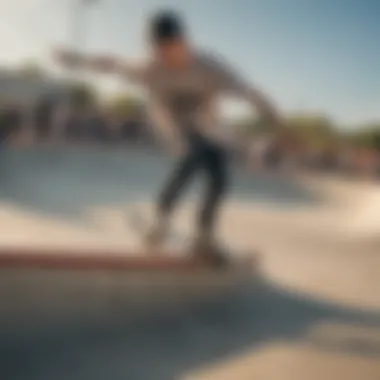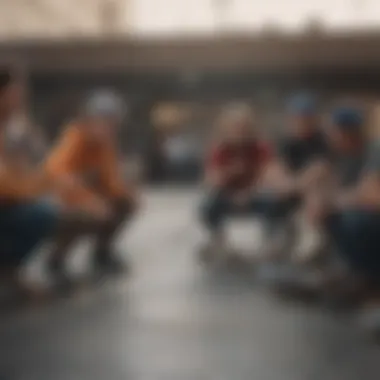Welcome to Skateboarding: Culture, Technique & Community


Intro
Skateboarding emerges as more than just an activity; it is a cultural phenomenon, an art form, and a means of expression for many. The roots of skateboarding date back to the 1940s, evolving from simple wooden boards to sophisticated technological marvels. It has fostered a vibrant community, connecting individuals from diverse backgrounds.
The essence of skateboarding lies in its spirit of freedom and creativity. It encourages personal expression and challenges. However, diving into skateboarding requires understanding its techniques, necessary gear, and safety measures. This article delves into these aspects, painting a comprehensive picture of skateboarding for both newcomers and seasoned skaters.
Techniques and Tips
Mastering skateboarding requires dedication, practice, and an understanding of key skills.
Skill Development
Skill development is essential in skateboarding. Beginners may start with basic movements like pushing off and balancing on the board. Progressively, one can learn to turn, carve, and gain speed. It is crucial to practice regularly in various environments to adapt to different surfaces and obstacles.
Practical Techniques
Learning practical techniques greatly enhances the skateboarding experience. In doing tricks, it helps to focus on the following:
- Starting with simple tricks like the Ollie before attempting more complex ones.
- Practicing regularly and understanding body movements.
- Watching tutorials online to learn techniques from experienced skaters.
Common Mistakes to Avoid
Skateboarders, especially beginners, often encounter mistakes that can hinder progress:
- Not wearing adequate protective gear.
- Trying advanced tricks too soon without mastering the basics.
- Skating on unsuitable surfaces that may lead to falls.
Gear and Equipment
Having the right gear can profoundly impact one's skateboarding adventure. Understanding essential equipment serves both performance and safety.
Essential Gear for Beginners
For newcomers, investing in minimal yet essential gear helps. Key items include:
- A quality skateboard designed for beginners.
- A helmet to protect against head injuries.
- Knee and elbow pads for additional safety.
Latest Innovations and Trends
Skateboard manufacturers continually roll out innovative designs. This includes advanced materials for lighter boards, better grip tape, and skateboard trucks for improved stability during tricks. Following industry trends helps enthusiasts make informed purchases.
Reviews and Comparisons
Before making a decision, checking reviews can be helpful. Engaging with communities on platforms like Reddit can provide insight into gear performance and user experiences. A balanced overview of different models helps one choose the right board.
Safety Measures
Prioritizing safety while skateboarding cannot be overstated. The thrill of riding must be balanced with potential risks.
Essential Safety Gear
Having the right safety gear is non-negotiable for skateboarders. Basic protective equipment includes:
- A certified helmet.
- Wrist guards to prevent injuries during falls.
- Padded shorts to cushion impacts.
Best Practices for Safe Participation
Participating in skateboarding safely relies on understanding one’s environment. Best practices include:
- Skating in designated areas to minimize risks.
- Being aware of surroundings to avoid hazards.
- Learning how to fall properly to reduce injury risk.
Injury Prevention and Management
As with any sport, injuries can occur. Basic first-aid knowledge is vital:
- Clean and bandage any cuts immediately.
- Ice any swollen areas to reduce pain and inflammation.
- Seek medical attention for severe injuries to ensure proper care.
Spotlights on Extreme Sports


Highlighting extreme sports contributes to a broader understanding of the skateboarding world.
Featured Sport of the Month
Each month, different extreme sports receive attention. This helps showcase various forms of skating, improving community awareness.
Profiles of Prominent Athletes
Prominent skateboarders have shaped the culture significantly. Learning about their journey and achievements can inspire both beginners and experienced skaters. Notable figures like Tony Hawk and Nyjah Huston often represent the sport in competitions and media, sharing their dedication and technique with emerging athletes.
Understanding Skateboarding
Skateboarding is not just a sport; it is a fusion of art, culture, and community. It is crucial to grasp the multi-faceted nature of skateboarding. By understanding the nuances of this activity, enthusiasts can appreciate its rich history and its impact on modern culture.
This section explores essential aspects of skateboarding—its definition, historical context, and its influence worldwide.
Defining Skateboarding
Skateboarding is a physical activity where individuals ride on a skateboard. The skateboard typically consists of a deck, wheels, and trucks. Riders perform various maneuvers, such as tricks and stunts, on flat surfaces or ramps. Beyond the technical definition, skateboarding embodies a sense of freedom and the spirit of rebellion.
It is an expression of creativity, allowing participants to craft their style. Skateboarding is inclusive, catering to a diverse range of individuals regardless of age or background.
Historical Background
Skateboarding emerged in California during the late 1940s. Initially, surfers adapted wooden boards to mimic surfing on land. The 1960s saw its rise as skateboarding culture began to form. The first skate parks were built, providing a dedicated space for enthusiasts.
By the 1980s, skateboarding entered the mainstream with increased popularity. Iconic skaters like Tony Hawk became household names, showcasing the sport through competitions and media appearances. The advent of skate videos further fueled its growth, influencing countless individuals to take up the sport. The history of skateboarding provides context to its development and cultural significance today.
Global Influence
Skateboarding has transcended borders, becoming a global phenomenon. It influences many aspects of culture, including fashion, music, and lifestyle. In places like Japan, skateboarding is tied to street fashion and art, while in Europe, it often intersects with music and community activism.
Various international competitions, such as the X Games, have taken the sport to new heights, showcasing talent from different countries. Skateboarding has also played a pivotal role in fostering social connections. Skateparks often serve as cultural hubs, where people come together to share experiences and skills.
Skateboarding's impact is both local and global, fostering a sense of community while allowing for individual expression.
In summation, understanding skateboarding involves recognizing its definition, appreciating its historical roots, and acknowledging its worldwide influence. This grasp lays the foundation for deeper exploration of skateboarding's culture, techniques, and community.
The Cultural Aspects of Skateboarding
Skateboarding transcends beyond mere physical activity or sport; it forms a substantial part of contemporary culture. The interplay of lifestyle, art, and media within the skateboarding scene highlights the intertwining elements that make this sport more than just tricks on a board. Recognizing these cultural aspects provides insight into how skateboarding fosters community, self-expression, and innovation.
Skateboarding as a Lifestyle
For many, skateboarding is not just a hobby; it is integrated into how they live. The skateboarding lifestyle emphasizes freedom, creativity, and resilience. Skateboarders often adopt a philosophy that values individuality and challenges norms. This community fosters a sense of belonging among its members, contributing to their identity.
*Key attributes of this lifestyle include:
- Community: Local skate parks or groups provide a space where skateboarders connect, skate, and grow together.
- Self-Expression: Skateboarding serves as a canvas for individuals to portray their style and personality through tricks and board designs.
- Adventure Seeking: The thrill of discovering new locations and pushing personal limits is a consistent draw for enthusiasts.
This lifestyle can be empowering and fulfilling. It encourages not just physical skills but also personal growth, risk-taking, and social connections.
Art and Fashion in Skateboarding
Art and fashion intersect closely with skateboarding, contributing to its visuals and cultural identity. Street art often finds a canvas in skate parks, with graffiti and murals that express the ethos of skating culture. Many skateboarders view themselves as part of an artistic movement, using their boards as an extension of their creativity.
Fashion also plays a significant role. Skateboards are often accompanied by specific attire that combines functionality with style. Brands like Vans and Thrasher reflect this merging of fashion with the skateboarding lifestyle. The aesthetics of skateboarding can communicate status, affiliation, and personal identity among skateboarders.
- Clothing: Loose-fitting and durable clothing is favored to allow ease of movement and comfort.
- Footwear: Shoes designed specifically for skateboarding provide the right balance of grip and support.
Ultimately, art and fashion in skateboarding elevate the sport into a cultural phenomenon, further amplifying its reach.
Skateboarding in Media
The media plays a crucial role in promoting skateboarding culture, expanding its visibility and appeal. Movies, documentaries, and influential skateboard magazines illustrate the depth of this sport, attracting new participants while celebrating existing community members.
"Skateboarding is a lifestyle that captures the spirit of youth and rebellion."
Social media platforms have transformed how skateboarders connect and share their experiences. Websites like Instagram, YouTube, or even Reddit serve as hubs for inspiration and community engagement. These platforms allow individuals to showcase their skills or discover new tricks from others around the world.


- Influencer Culture: Well-known skateboarders leverage their social platforms for brand partnerships and personal branding.
- Online Communities: Forums and discussion threads create supportive environments for skateboarders of all levels to share knowledge and experiences.
Techniques for Aspiring Skateboarders
Understanding the techniques in skateboarding is pivotal for anyone considering this thrilling activity. Mastery of these techniques not only enhances your abilities but also increases your confidence on the board. Whether you are a beginner aiming to learn the basics or an experienced rider wanting to refine your skills, focusing on the right techniques can yield significant benefits. Skateboarding is not just about performing tricks; it is also about movement, balance, and control.
Fundamentals of Skateboarding
Skateboarding begins with the fundamentals, which include stance, pushing, and stopping. Your stance is crucial; it defines how you ride. Regular riders (left foot forward) and goofy riders (right foot forward) should find comfort in their stance. Practice pushing off the board and ensuring your balance is centered.
Pushing off efficiently is essential for acceleration. Use back foot to push while classic front foot is positioned securely. Stopping safely is equally important. There are various stopping methods; foot braking is common among beginners as it allows for quick stops. Learning to heel drag and powerslide can offer more control.
Common Tricks and Their Execution
Once the fundamentals are mastered, you can start exploring common tricks. Tricks like the ollie, kickflip, and grab are foundational to skateboarding. The ollie is often the first trick that beginners learn, as it serves as a stepping stone to many others. To perform an ollie, pop the tail of the skateboard down while dragging your front foot upward. This creates the lift you need to jump off the ground.
The kickflip adds a flip to the ollie. Execute it by rotating your front foot in a sideways motion, which sends the board spinning underneath you. The grab trick involves reaching down and holding your board mid-air. Each trick requires practice and patience; improving your execution will enhance your overall skateboarding ability.
Transitioning to Advanced Skills
As confidence builds, riders may want to transition to advanced skills. This includes more complex tricks, grinding, or even learning to skate vert ramps. Consistent practice is the key to moving from basic skills to advanced techniques.
Grinds and slides require you to use the trucks of your skateboard to grind along ledges or rails. It is recommended to start with wider obstacles and progress to narrower ones. Skating on vert ramps involves a different technique altogether. It requires understanding the physics of momentum and balance.
Before attempting advanced tricks, consider gradually increasing the difficulty of your practice. Always keep safety a priority.
Skateboarding is not just about the tricks; it's a continual process of learning and self-improvement.
A strong foundation leads to better performance. Remember, patience and persistence are essential in your skateboarding journey.
Gear and Equipment
The significance of proper gear and equipment in skateboarding cannot be overstated. Choosing the right skateboard, investing in protective gear, and maintaining the equipment are essential components to enhance both performance and safety. This section delves into those aspects and aids in understanding the importance of each element for any skateboarder.
Choosing the Right Skateboard
Selecting the appropriate skateboard is a crucial decision that influences riding experience. Skateboards come in various shapes, sizes, and materials, making it essential to consider personal needs and preferences. Different skateboards serve different purposes such as cruising, street skating, or performing tricks. For example, a wider board provides more stability, while a narrower one enables agility for tricks.
When choosing a skateboard, pay attention to the following factors:
- Deck Material: Common materials include maple, bamboo, and fiberglass. Maple is sturdy and versatile; bamboo is usually lighter; fiberglass boards offer enhanced flexibility.
- Deck Shape: Choose between a popsicle shape for tricks, a cruiser shape for riding, and a longboard for downhill riding. Each shape offers unique riding styles.
- Wheel Hardness: Softer wheels are better for rough terrain, while harder wheels are suitable for smooth surfaces. Consider your typical skating environment.
- Truck Width: This should match the deck width for optimal performance. Wide trucks provide stability, while narrow trucks allow for sharper turns.
Protective Gear Essentials
Safety is paramount in skateboarding. The sport can involve falls and spills, so using protective gear is not an option but a necessity. Essential protective gear includes helmets, knee pads, elbow pads, and wrist guards. Each component plays a critical role in minimizing injuries.
- Helmets: Look for helmets that meet safety standards like the CPSC, ensuring proper protection for the head.
- Knee and Elbow Pads: These pads protect the joints from abrasions and impact injuries. They should fit snugly without being uncomfortably tight.
- Wrist Guards: These help prevent sprains and fractures. They are particularly important for beginners still mastering balance.
Investing in quality protective gear can help make your skateboarding experience safer and more enjoyable.
Maintenance for Longevity
Skateboards, like any equipment, require regular maintenance to remain in good condition. Taking simple steps can extend the longevity of both the board and its components.
- Regular Inspections: Check for cracks or warps in the deck, loose screws on the trucks, and wear on the wheels. Address any issues promptly to prevent accidents.
- Cleaning: Dirt and debris can damage the wheels and bearings. Regularly clean the wheel and bearings with a cloth and suitable solvents.
- Bearing Maintenance: Keep the bearings lubricated. This ensures smoother rides and prolongs bearing life.
- Replacing Worn Parts: Recognize when it’s time to replace parts like wheels and grip tape. Worn wheels can affect speed and grip.
By following these steps, you can enhance the durability of your skateboard and ensure a consistent performance.
Remember, the right gear and regular maintenance can significantly impact your safety, performance, and overall skateboarding experience.
For more information on skateboarding techniques and safety, check out resources at Wikipedia or explore communities on Reddit.
Safety Practices in Skateboarding
The significance of effective safety practices in skateboarding cannot be overstated. Skateboarding, while offering immense joy and thrill, also presents various risks. Understanding these risks, implementing best practices, and establishing emergency preparedness plans can make the difference between a positive skating experience and a dangerous one. By focusing on these elements, skateboarders can protect themselves and cultivate a safer skating environment for everyone.
Understanding Risks


Skateboarding involves various risks. Falling is an inherent part of the activity. Injuries can range from minor scrapes and bruises to more serious injuries like fractures or concussions. This understanding is essential for both beginners and experienced skateboarders.
Common risks include:
- Inadequate protective gear: Skaters who do not use safety equipment are at a higher risk for injuries.
- Environmental hazards: Uneven surfaces, obstacles, and wet conditions contribute to falls.
- Level of skill: Skateboarders attempting advanced tricks without proper preparation often face greater chances for injury.
Awareness of these risks empowers skaters to make informed decisions about their practices.
Best Practices for Safe Skating
Adopting best practices leads to better safety while skateboarding. Here are some essential recommendations:
- Wear Protective Gear: A helmet, knee pads, elbow pads, and wrist guards reduce the likelihood of serious injuries. Make sure all gear fits properly.
- Choose Safe Locations: Seek out designated skate parks or smooth, flat surfaces that are free from debris. Avoid private properties unless you have permission.
- Inspect Equipment Regularly: Check your skateboard for any damage. Loose trucks or worn-out wheels can lead to accidents.
- Warm Up and Stay Alert: Stretch before skating to prevent strains. Always remain aware of your surroundings to anticipate potential hazards.
"Preventive measures save lives, especially in fast-paced activities like skateboarding."
Emergency Preparedness
Accidents can happen, even with the best practices in place. Therefore, having an emergency preparedness plan is crucial:
- First Aid Kit: Always keep a basic first aid kit accessible at your skating spot. It should include band-aids, antiseptic wipes, and ice packs.
- Get Trained: Knowing basic first aid and CPR can be invaluable. Consider taking a course to be ready in case of emergencies.
- Have Contacts Ready: Keep emergency contact numbers easily accessible. This includes doctors and local emergency services.
- Stay Together: Skateboarding with friends can help. If an injury occurs, others can provide assistance or seek help quickly.
Establishing a solid approach towards safety in skateboarding enhances not only personal well-being but influences the community culture positively. Emphasizing safety ensures that skateboarding remains an enjoyable and sustainable activity for all.
Building Community through Skateboarding
Creating a strong community is a vital aspect of skateboarding. It serves not only as a source of camaraderie but also as a support system for skaters of all backgrounds and skill levels. When enthusiasts come together, they foster an environment that promotes learning, sharing, and personal development. This section explores how skate parks, events, and online communities contribute to this vibrant culture.
Skate Parks as Social Hubs
Skate parks are more than just spaces designed for practicing tricks and skills. They are essential social hubs within the skateboarding community. At these locations, skaters gather to exchange techniques, share stories, and form friendships.
The design of a skate park often encourages interaction. Features like bowls, ramps, and rails invite skaters to challenge each other. This shared experience builds a sense of belonging. Skaters often form bonds over similar interests, leading to friendships that extend beyond the park itself. Being part of a community can enhance one's passion for the sport. These interactions can motivate skaters to push their limits while maintaining safety.
Events and Competitions
Events and competitions in skateboarding play a crucial role in enhancing community ties. They offer opportunities for both seasoned and novice skaters to showcase their skills. Competitions generate excitement and foster a spirit of healthy rivalry. Participants often find themselves inspired by others' performances. Besides competition, these gatherings serve as platforms for learning, where skaters receive feedback from more experienced peers.
"Competitions are the lifeblood of our culture. It’s where I met most of my friends and learned some of the best tricks. The thrill of skating together changes everything."
- An avid skateboarder
Additionally, skateboarding events often include music, art displays, and vendor stalls that expand the culture beyond just skating. They create a festival atmosphere that invites non-skaters to engage and learn about the sport, broadening the community even further.
Online Communities and Forums
In today's digital age, online communities play an important role in connecting skateboarders across the globe. Platforms like Reddit and Facebook provide spaces for discussions, sharing tips, and promoting local events. These virtual arenas allow skaters to interact with others who might not be physically close to them.
Subreddits dedicated to skateboarding offer advice on gear, tricks, and safety, while Facebook groups facilitate local meet-ups and events. The ability to connect online nurtures a sense of belonging among skaters who may not have access to skate parks or local events in their area. This network makes it easier for skaters to find their niche, regardless of their geographic location.
Engaging in online forums can also help newcomers feel welcomed. Access to resources, shared experiences, and support from experienced skaters fosters growth and confidence in their skating journey.
The Future of Skateboarding
The future of skateboarding is a topic of vital importance in understanding where the sport is headed and how it will evolve. As with many sports and activities, skateboarding is constantly influenced by technological advances, cultural shifts, and environmental factors. This section aims to explore these elements, considering both the benefits of these changes and the challenges they pose to the skateboarding community.
Evolution of Technology
Technology plays a significant role in shaping the future of skateboarding. Innovations in skateboard design, materials, and manufacturing processes have dramatically increased performance and durability. For example, advances in composite materials allow for lighter and more resilient boards. This evolution means that skateboarders can enjoy improved maneuverability and control.
Furthermore, digital technology is also impacting the sport. Skateboarding apps for learning tricks, tracking performance, and connecting with other skate enthusiasts are becoming commonplace. Virtual reality (VR) enables users to experience skateboarding in new ways, including simulations of skate parks or learning experiences based on real-world tricks. These developments broaden the horizons for learning and community building.
Cultural Shifts and Adaptability
As skateboarding continues to grow and change, its culture is adapting to modern societal norms. Diversity and inclusion have become essential themes in skateboarding. The community is increasingly encouraging participation among individuals from various backgrounds. This shift not only enriches the sport but also brings fresh perspectives to techniques and styles.
Skateboarding has also embraced sustainability as a core principle. Brands are responding to consumer demand for eco-friendly products, resulting in boards and gear made from recycled materials. This cultural adaptation signals a growing awareness within the community about its role in promoting environmental responsibility.
Environmental Considerations
In light of evolving global challenges, the skateboarding community faces the imperative to consider its environmental impact. Skate parks often require considerable resources, and their construction can lead to habitat disruption. As awareness of environmental issues expands, so does the push for sustainable practices within the sport. Skateboard manufacturers are now exploring biodegradable materials and ethical sourcing.
"The integration of sustainability in skateboarding not only benefits the environment but also enhances the brand image of manufacturers and retailers."
By addressing these environmental considerations, the skateboarding community can continue to enjoy the sport while ensuring it remains compatible with the planet's health. Looking ahead, the future of skateboarding is likely to witness a more profound engagement with sustainability initiatives, cultural inclusivity, and technological advancements, shaping a community that values both progression and responsibility.







